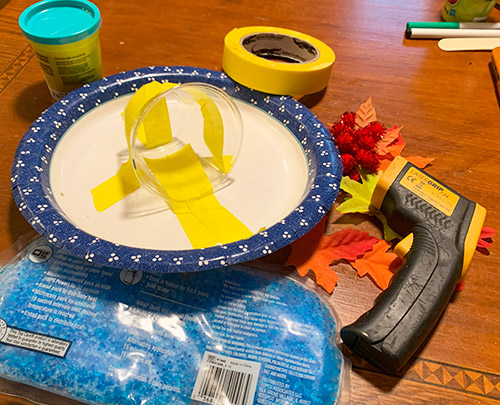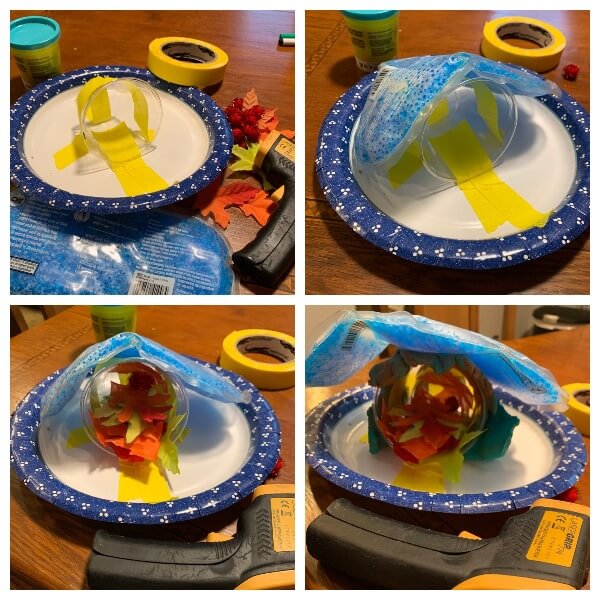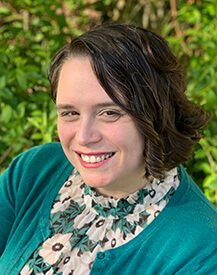Autumn Animal Antics

Hibernation Lesson Plans for Preschool
In this hibernation lesson plan for preschool, we talk about what animals
do in the fall to prepare for the upcoming winter.
Ages/Grades
Preschool, Early Elementary
Learning Domains
Science, Fine Motor
Materials:
- • Paper Plate (1 per student or small group)
- • Plastic cup (1 per student or small group)
- • Tape
- • Leaves (real, plastic, or fabric)
- • Clay (air dry or dough)
- • Thermometer (IR digital will work best)
- • Ice in a bag or an ice pack
- • Pom poms, balls, plastic food, toys, balled-up paper, etc. (something small to be gathered)
- • Buckets
- • Backpacks, purses, or fanny packs
Ready, Set, Create!
![]() Flying South
Flying South
Find a large space in your classroom and tape a V shape on the floor. Stand at the point of the V and then ask your students to line up on the V and face you.
Ask them to do what you do. Flap your arms. Try flapping slowly and then quickly and encourage them to match your speed- throw in some honking for good measure!
Let other students have a chance to be the goose leader.
![]() Gathering Food
Gathering Food
Spread the “food” that will be collected throughout the classroom or playground.
Some students will collect and store their food like tree squirrels and chipmunks. Place buckets around the room and they can “stash” their food in these buckets as they gather it.
Some students will collect food and “eat” it like woodchucks and bears. Give these students backpacks or fanny packs that they can wear on the front of their bodies as their “bellies.” As they collect food, eat it by putting it in their bags.
![]() Build a Warm Den
Build a Warm Den
Before the lesson, lay a plastic cup on a paper plate and tape it down. This will be the den for each student or group of students.
Let students place their hands in the cup while you place the ice pack on top. If you’re using a digital thermometer, take the temperature of the area in the cup.
Challenge the students to make the den warmer by adding leaves and grass to the cup. Then, place their hands inside, nestle in the leaves and grass, and add the ice pack to the top of the cup. Does it feel warmer? Take the temperature again.
Finally, add the clay to the outside of the cup- now your den is underground! Place the student’s hands back inside and add the ice pack. How warm is the den now? Add their second hand (if there’s room) like animals snuggling up together. Take one more temperature reading.

Engage Children in Conversation
Talk about what animals do in the fall to prepare for the upcoming winter. Some animals gather food. Animals that gather food either eat it right away to prepare for hibernation while others store the extra food to be eaten all winter. Some animals fly to warmer climates while others spend the fall making a nice warm den to spend the winter in. Share pictures and videos of animals doing all of these behaviors.
Ask children open ended questions that encourage critical thinking, such as:
What do human animals do in the fall? If you were a different animal, which do you think you’d want to do in the fall- gather lots of food and build a den or fly to somewhere warmer?
Was it hard to match me when I was flapping my arms? Did you feel tired at any point during this game?
Was it easier to collect food when you were eating it or when you were stashing it? Can you share food with each other as a stasher or an eater?
Extensions
Allow the students access to all the supplies, and include man-made materials like pom poms, felt, cut up old socks or mittens and challenge them to make the warmest den they can make!
 Hollie is certified K-8 teacher who has been educating in the informal education field since 2005. She has developed and implemented countless exciting STEAM programs for families, classrooms, and teachers focused on the natural world, the scientific process, and ancient life. Her professional passions are inquiry, whole family learning, experiential learning starting in early childhood, and the intersection of literacy and science instruction.
Hollie is certified K-8 teacher who has been educating in the informal education field since 2005. She has developed and implemented countless exciting STEAM programs for families, classrooms, and teachers focused on the natural world, the scientific process, and ancient life. Her professional passions are inquiry, whole family learning, experiential learning starting in early childhood, and the intersection of literacy and science instruction.
She has recently developed a community-based program that encourages families to use dramatic play to learn science, increase literacy skills, and have fun together for which she received the Drexel University Presidential Award for Civic Engagement. She is most proud of her work on a popular science storytelling program for preschool families and classrooms that combines a book club format with engaging programs, innovative curriculum, and a hysterical puppet storyteller.
